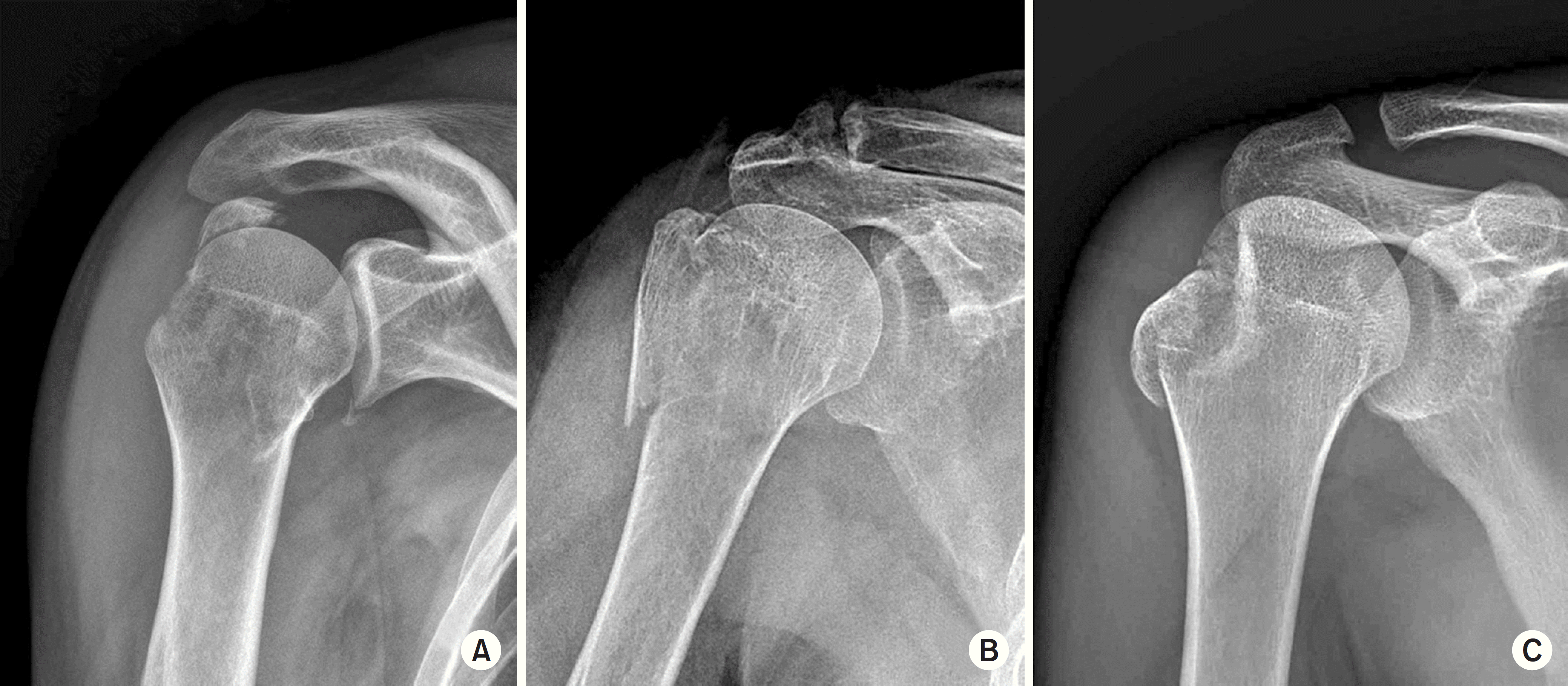Abstract
Purpose
The purpose of this study was to compare the characteristics and clinical features of greater tuberosity fractures with or without a shoulder dislocation.
Materials and Methods
A total of 108 cases of greater tuberosity fractures (56 cases with shoulder dislocation, 52 cases without shoulder dislocation) were reviewed retrospectively. Age, sex, side, injury mechanism, fracture displacement, fracture morphology, number of fracture fragments, main fragment size, treatment, and combined injuries were investigated.
Results
The age, sex, side, injury mechanism, treatment, and combined injuries were similar in both groups (p>0.05). A statistically significant difference in fracture displacement, fracture morphology, number of fracture fragment, and main fragment size was observed between the two groups (p<0.05).
Conclusion
In greater tuberosity fractures with a shoulder dislocation, the prevalence of fracture displacement was high and the depression type of fractures occurred frequently. In addition, the number and size of the fracture fragment increased. Therefore, an understanding of these fracture patterns will be helpful for deciding treatment and prognosis.
Go to : 
References
1. Gruson KI, Ruchelsman DE, Tejwani NC. Isolated tuberosity fractures of the proximal humeral: current concepts. Injury. 39:284–298. 2008.
2. Bono CM, Renard R, Levine RG, Levy LS. Effect of displacement of fractures of the greater tuberosity on the mechanics of the shoulder. J Bone Joint Surg. 83:1056–1062. 2001.

3. George MS. Fractures of the greater tuberosity of the humerus. J Am Acad Orthop Surg. 15:607–613. 2007.

4. Green A, Izzi J Jr. Isolated fractures of the greater tuberosity of the proximal humerus. J Shoulder Elbow Surg. 12:641–649. 2003.

5. Hawkins RJ, Angelo RL. Displaced proximal humeral fractures. Selecting treatment, avoiding pitfalls. Orthop Clin North Am. 18:421–431. 1987.

6. Park TS, Choi IY, Kim YH, Park MR, Shon JH, Kim SI. A new suggestion for the treatment of minimally displaced fractures of the greater tuberosity of the proximal humerus. Bull Hosp Jt Dis. 56:171–176. 1997.
7. Platzer P, Kutscha-Lissberg F, Lehr S, Vecsei V, Gaebler C. The influence of displacement on shoulder function in patients with minimally displaced fractures of the greater tuberosity. Injury. 36:1185–1189. 2005.

8. Atoun E, Narvani A, Even T, et al. Management of first-time dislocations of the shoulder in patients older than 40 years: the prevalence of iatrogenic fracture. J Orthop Trauma. 27:190–193. 2013.
9. Bigliani LU, Flatow EL, Pollock RG. Fractures of the proximal humerus. Harryman DT, Matsen FA, Rockwood CA, Wirth MA, editors. The shoulder. vol. 1. 2nd ed.Philadelphia, B Saunders: 337–390;1998.
10. Iannotti JP, Sidor M. Malunions of the proximal humerus. Warner JJP, Iannotti JP, Gerber C, editors. Complex and revision problems in shoulder surgery. Philadelphia: Lippincott-Raven;p. 245–264. 1997.
11. Craig EV. Open reduction and internal fixation for greater tuberosity fractures, malunions and nonunions. In: Craig EV ed. Master techniques in orthopaedic surgery: the shoulder. New York, Raven Press: 289–307,. 1995.
12. Kim YK, Ko KC. Arthroscopic findings in acute shoulder dislocation associated with a fracture of greater tuberosity of the humerus. J Korean Orthop Assoc. 35:437–441. 2000.

13. Bahrs C, Lingenfelter E, Fischer F, Walters EM, Schnabel M. Mechanism of injury and morphology of the greater tuberosity fracture. J Shoulder Elbow Surg. 15:140–147. 2006.

14. Müller ME, Nazarian S, Koch P, Schatzker J. The comprehensive classification of fractures of long bones. New York: Springer;1990.
15. Mutch J, Laflamme GY, Hagemeister N, Cikes A, Rouleau DM. A new morphological classification for greater tuberosity fractures of the proximal humerus: validation and clinical implications. Bone Joint J. 96:646–651. 2014.
16. Horak J, Nilsson BE. Epidemiology of fracture of the upper end of the humerus. Clin Orthop Relat Res. 112:250–253. 1975.

17. Neer CS 2nd. Displaced proximal humeral fractures. I. Classification and evaluation. J Bone Joint Surg Am. 52:1077–1089. 1970.

18. Siegel JA, Dines DM. Techniques in managing proximal humeral malunions. J Shoulder Elbow Surg. 12:69–78. 2003.

19. Moon ES, Kim MS, Kim YJ. The surgical outcomes for isolated greater tuberosity fracture of proximal humerus. J Korean Fract Soc. 20:239–245. 2007.

Go to : 
 | Fig. 1.Morphological classification of greater tuberosity fractures. (A) Avulsion-type fracture. (B) Split-type fracture. (C) Depression-type fracture. |
Table 1.
Characteristics of GT Fractures with or without Shoulder Dislocation
Table 2.
Fracture Pattern in Relation to a Shoulder Dislocation




 PDF
PDF ePub
ePub Citation
Citation Print
Print


 XML Download
XML Download